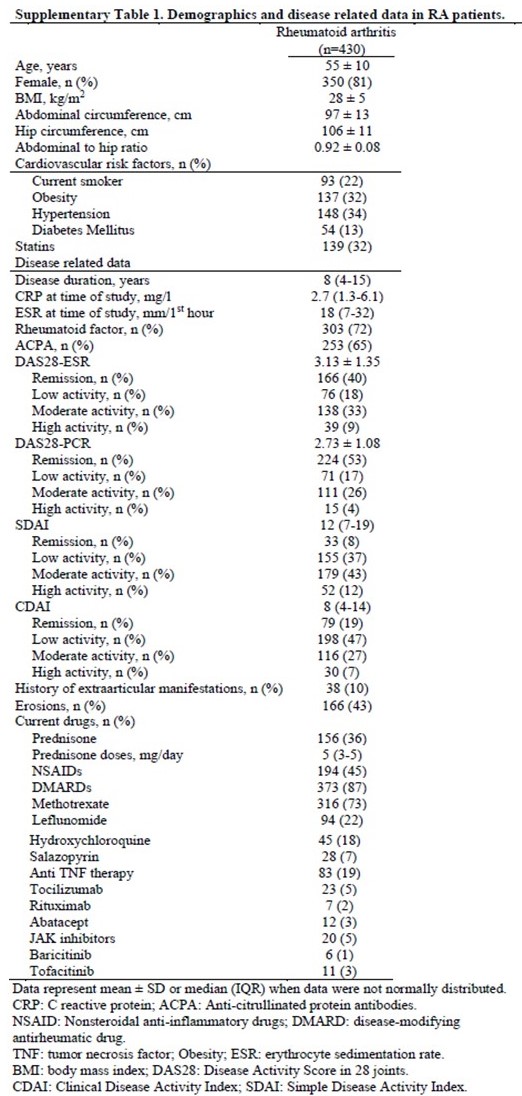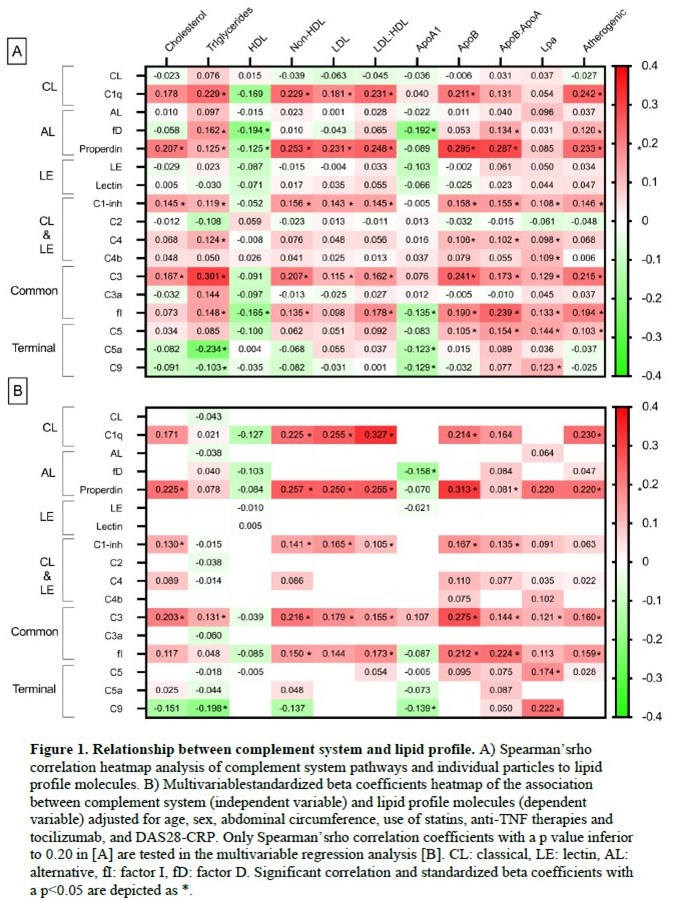Session Information
Session Type: Poster Session C
Session Time: 10:30AM-12:30PM
Background/Purpose: The complement system has been linked to the etiopathogenesis of rheumatoid arthritis (RA). Patients with RA exhibit a dysregulated profile of lipid molecules, which has been attributed to the inflammation present in the disease. In this study, we aimed to evaluate the association between a comprehensive assessment of the complement system and the lipid profile of RA patients.
Methods: Four hundred thirty patients were recruited. New-generation techniques were employed to conduct functional assays of the three pathways of the complement system. Serum levels of various complement components such as C1q, lectin, C2, C4, C4b, C1-inhibitor, C3a, C5, C5a, and C9 were assessed. Furthermore, a complete pattern of lipid molecules was measured including high (HDL), low-density lipoproteins (LDL), and lipoprotein(a). Multivariable linear regression analysis was conducted to investigate the association between the complement system and lipid profile in RA patients.
Results: Demographic- and disease-related characteristics of the participants are shown in supplementary table 1.
Spearman’s rho correlation heatmap analysis of C system pathways and individual particles to lipid profile molecules are shown in figure 1-A. Most of the associations were positive (in red). Only HDL and ApoA1, which are molecules with beneficial lipid properties, showed a negative relationship (in green). Significant associations were predominant in the upper part of the heatmap, corresponding to the upstream C zymogens. Thus, C1q, which belongs to the early classical pathway, showed a significant relationship with all C molecules except HDL, apolipoprotein A1, and lipoprotein(a). Properdin also showed associations with all lipid profile molecules apart from apolipoprotein A1 and lipoprotein(a). C1-inhibitor, factor I, and C3a were among the particles that showed higher associations with different lipid molecules. The C activation products C3a and C5a did not show association with the lipid profile.
Standardized beta coefficients in figure 1-B are adjusted for age, sex, abdominal circumference, use of statins, anti-TNF therapies and tocilizumab, and DAS28-CRP. C1q retained significant and positive associations with non-HDL and LDL-cholesterol, LDL:HDL and ApoB:ApoA1 ratios, ApoB, and the atherogenic index. Also, properdin serum levels were significantly associated with total cholesterol, non-HDL, LDL and LDL:HDL ratio and atherogenic index. Several other associations identified in the univariable analysis were also preserved. Again, functional C assays and activated C forms showed no correlation with the lipid pattern.
To ascertain how our findings correlate with specific lipid values known to impact cardiovascular disease or cardiovascular events, we examined the association of the C system with LDL >130 mg/dl, an atherogenic index >4, and the presence of dyslipidemia. This analysis was adjusted for the aforementioned potential confounders. Its results are shown in table 1.
Conclusion: Patients with RA exhibit an independent relationship between the C system and a detrimental lipid profile. This relationship is primarily associated with upstream complement components rather than activated ones.
To cite this abstract in AMA style:
Garcia-Gonzalez M, Gomez-Bernal F, Quevedo-Abeledo J, Gonzalez-Gay M, Ferraz-Amaro i. Relationship Between the Complement System and Serum Lipid Profile in Patients with Rheumatoid Arthritis [abstract]. Arthritis Rheumatol. 2024; 76 (suppl 9). https://acrabstracts.org/abstract/relationship-between-the-complement-system-and-serum-lipid-profile-in-patients-with-rheumatoid-arthritis/. Accessed .« Back to ACR Convergence 2024
ACR Meeting Abstracts - https://acrabstracts.org/abstract/relationship-between-the-complement-system-and-serum-lipid-profile-in-patients-with-rheumatoid-arthritis/



